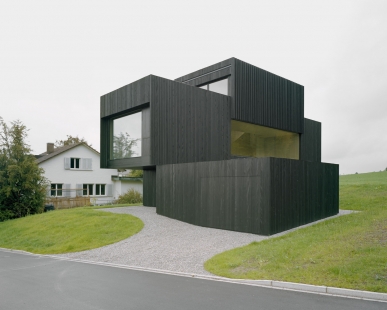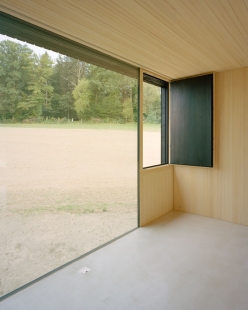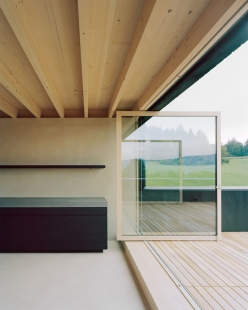
Detached House Aarau
Einfamilienhaus Aarau

The building ground is located slightly elevated on the edge of a housing development and borders three-sided to the agricultural zone. The wide open space is decisive to this architectural concept. The house and its surrounding design are a part of this generous landscape space.
Neither garden fencing nor plants should delineate the perimeter border and restrict the openness of the landscape. Due to the arrangement of the dining room with the kitchen on the attic floor, the requirement for a versatile outdoor space with a high degree of privacy could be implemented. Furthermore, the view of the adjacent forest and the surrounding landscape could be optimally staged.
The dining room is connected to the living area below by an open space. This room, as well as the children's rooms arranged at the two front facades of the building, are generously glazed and offer a beautiful view. A bathroom completes the space on this floor. The entrance to the house and the open-plan sleeping area for the parents with an office desk and shower room are located on the ground floor. A step marks the transition from the entrance to the private parent's area. This level difference and the elongated shape of the building allow the house to be gently embedded in the terrain that rises on two sides.
The three floors are spatially connected by a cascading staircase. The sequence of rooms enables a view as far as the terrace on the attic floor when entering the house. The two-story building with an attic and the attached garage forms a sculpture, which generates a courtyard-like seating area, a covered entrance, and a covered outdoor space on the ground floor. This house on the edge of the forest and its carpentry are made of glue-free solid wood systems with local silver fir and ash trees. In addition to the solid limestone floor, a pleasant, biologically high-quality indoor climate and sustainable construction are achieved.
Neither garden fencing nor plants should delineate the perimeter border and restrict the openness of the landscape. Due to the arrangement of the dining room with the kitchen on the attic floor, the requirement for a versatile outdoor space with a high degree of privacy could be implemented. Furthermore, the view of the adjacent forest and the surrounding landscape could be optimally staged.
The dining room is connected to the living area below by an open space. This room, as well as the children's rooms arranged at the two front facades of the building, are generously glazed and offer a beautiful view. A bathroom completes the space on this floor. The entrance to the house and the open-plan sleeping area for the parents with an office desk and shower room are located on the ground floor. A step marks the transition from the entrance to the private parent's area. This level difference and the elongated shape of the building allow the house to be gently embedded in the terrain that rises on two sides.
The three floors are spatially connected by a cascading staircase. The sequence of rooms enables a view as far as the terrace on the attic floor when entering the house. The two-story building with an attic and the attached garage forms a sculpture, which generates a courtyard-like seating area, a covered entrance, and a covered outdoor space on the ground floor. This house on the edge of the forest and its carpentry are made of glue-free solid wood systems with local silver fir and ash trees. In addition to the solid limestone floor, a pleasant, biologically high-quality indoor climate and sustainable construction are achieved.
Gautschi Lenzin Schenker Architekten
0 comments
add comment






































